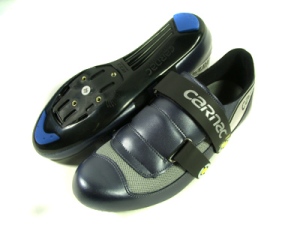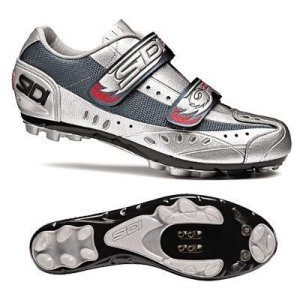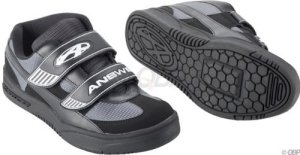To clip, or not to clip? Clip. We’ve already written a post about cycling pedals, but I decided to go ahead and put up a post about shoes for the new year. We’re going to look at the benefits of the different types of shoes you can buy for your ride and hopefully help you choose the correct cycling shoe for your ride.
Remember these things when choosing the right cycling shoes:
- The stronger the sole, the more power is transferred to the pedal.
- If you have wide feet, be careful choosing road style shoes, they often come narrowly designed.
- Ensure a snug fit with a little room in the toes to move around in cold weather.
- Ensure the fit at the ball of your foot, where you connect to the pedal, isn’t too tight or you will suffer from numbness in your toes. You need a little up and down space to keep blood moving.
- Ensure there is no slipping in the heel. You need a nice heel cup and not a flat sole.
In general, there are three types of cycling shoes on the market. There are a number of special variations, but we’ll focus on the main three.
- BMX
- Mountain
- Road
Road shoes are what most people conjure up when thinking about the Tour de France and cycling. These shoes are designed for riding and are often difficult to walk in. Since they are specifically designed for cycling, they often have exposed cleats to ensure the sole is made of one strong piece of material. As you’ll learn later, mountain shoes often have recessed cleats that cut into the sole and lessen it’s strength. Road shoes are often of a much narrower design, more lightweight, and stronger than other shoes. Have a look at the exposed cleats on this model and imagine walking around in them:

Road Cycling Shoes
Mountain cycling shoes are a little different than road shoes in that they usually have recessed cleats. This makes the shoe much more comforable to walk in when not clipped into the bike. Typically these shoes will have rubber/nylon soles on the outer rim of the sole to shed mud and pad your footsteps. Because of this added sole, the weight of these shoes is generally higher than a road shoe, but not a ton. You can check to see how good the shoes are at shedding mud and water by checking the gaps between the sole pieces. It’s hard to explain further, but you’ll understand if you flip the shoe over and check the spacing. Bigger spaces lead to better clearning ability. I briefly mentioned earlier that having a recessed cleat can weaken the sole of a cycling shoe. Basically there is a 2x3cm piece taken out of the sole to fit in the cleat. Remember this is you are going for speed, it might make a difference for you and make it worthwhile to pick up road shoes and carry another pair of shoes for walking around. For us bicycle tourers, a softer sole is worth saving on bringing an entire extra pair of shoes to walk around in. Having two shoes in one is priceless on a long bike tour. Looking at the picture below, you can see the recessed cleat, the extra rubber sole and mud-clearning gaps, and the heel cup.

Mountain Cycling Shoes
BMX shoes come in models with or without clips because BMX riders use platform pedals and don’t require clipping in at all times because it can become dangerous. Imagine doing a nice backflip and having your foot stuck in the pedal. That would suck. Some riders do prefer the feeling of clipping in and so there are models of BMX shoes available with slips. BMX shoes typically look like skate shoes because of their wide, flat soles . Have a look at a typical BMX shoe below:

BMX Clipless Shoes
Once you’ve chosen the style of your cycling shoe, you’ve got to choose the quality. Generally, there are three levels of quality when it comes to buying bike shoes.
- Beginner
- Economic
- Performance
Beginner
Obviously, these shoes are of the lowest quality and lowest price of our three choices of cycling shoes. The soles of these shoes are the flimsiest of the bunch, often made of rubber (heavy) or nylon (cheap). The upper part of the shoe is made of nylon,synthetic leather, suede, or mesh.
Economic
These are your mid-range cycling shoes, usually these can be bought for anywhere between 80-120 dollars. A lot of Shimano, Forte, and Pearl Izumi models fit into this category. These bike shoes typically come with some sort of composite sole made up of nylon or some carbon fiber. The upper part of the shoe is made of leather, nylon, mesh, or other materials. Most of these models will also come with a molded heal cup to position you for max power.
Performance
These are your expensive cycling shoes, usually ranging from 150-250 and higher. If you are a serious road racer or cyclist, this is your target range. These bike shoes come with carbon-fiber soles and high quality upper materials made of pure leather or microfibers for maximum breathability. Some popular performance models include Sidi, Cannondale, Lake, Vittoria, and Adidas.
I hope this helps you choose the right cycling shoes. Remember, if you’re on a tour and need extra space, get a multi-purpose biking shoe with a recessed cleat so you don’t have to carry an extra pair of shoes.
Don’t forget that one of the most important aspects of power transfer are the soles of your shoe. A weak and flimsy sole isn’t going to transfer as much power at a solid piece of sole. Because of this, cheaper shoes are going to be much flimsier than the more expensive models, mostly because of build materials.
REI January Super Clearance! Jan 9-19
Learn more about my upcoming 8,500mile bicycle trek from South Korea to Portugal at my new website. Click on the logo.


You must be logged in to post a comment.